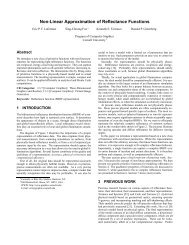pigmented colorants: dependence on media and time - Cornell ...
pigmented colorants: dependence on media and time - Cornell ...
pigmented colorants: dependence on media and time - Cornell ...
You also want an ePaper? Increase the reach of your titles
YUMPU automatically turns print PDFs into web optimized ePapers that Google loves.
ceptually appears as adding white to the sample, giving a faded appearance. Sev-<br />
eral other pigments experienced similar results, though not all pigments underwent<br />
changes during the experiment. In unprotected atmospheres (without the use of<br />
activated carb<strong>on</strong> filters) it would take three (outdoor) to six (indoor) years to<br />
accumulate a dose (c<strong>on</strong>centrati<strong>on</strong> <strong>time</strong>s magnitude) of oz<strong>on</strong>e exposure from the<br />
atmospheric oz<strong>on</strong>e c<strong>on</strong>centrati<strong>on</strong>s measured <strong>and</strong> reported in the work. Pigment<br />
size is also a major factor influencing the surface area exposed to the air, which<br />
may influence the rate of reacti<strong>on</strong> with the chemical.<br />
Similarly, nitrogen dioxide is a comm<strong>on</strong> air pollutant formed in the atmosphere<br />
from the nitric oxide emissi<strong>on</strong>s from fuel combustible sources. Whitmore <strong>and</strong><br />
Cass found more than half of the natural organic pigment <str<strong>on</strong>g>colorants</str<strong>on</strong>g> studied had<br />
a significant color change ∆E >2 from exposure to 0.50 ppm NO2 in air for 12<br />
weeks [WC89]. A dose of this magnitude would be experienced inside an unpro-<br />
tected museum in a few years (2-6 years) in an urban setting. The procedure for<br />
the experiment was similar to that of the oz<strong>on</strong>e exposure, menti<strong>on</strong>ed previously.<br />
All of these chemical effects are cumulative <strong>and</strong> irreversible. In relati<strong>on</strong> to the<br />
durati<strong>on</strong> of a piece of artwork, these pigment changes occur rather quickly. Care<br />
must be taken to protect artwork from such harsh c<strong>on</strong>diti<strong>on</strong>s.<br />
All in all, the appearance of color of <str<strong>on</strong>g>pigmented</str<strong>on</strong>g> materials in not c<strong>on</strong>stant <strong>and</strong><br />
can be the result of a number of different factors. Through the use of spectropho-<br />
tometers, <strong>on</strong>e can accurately measure theses changes over <strong>time</strong>. Through the use<br />
of mathematical predictive color mixing systems, such as Kubelka Munk theory,<br />
further changes can be predicted. Hopefully, this knowledge will minimize the risk<br />
of further deteriorati<strong>on</strong> of artwork for future generati<strong>on</strong>s. Equally enticing is the<br />
use of the data to travel back in <strong>time</strong> to see a painting in its original brilliance.<br />
135



